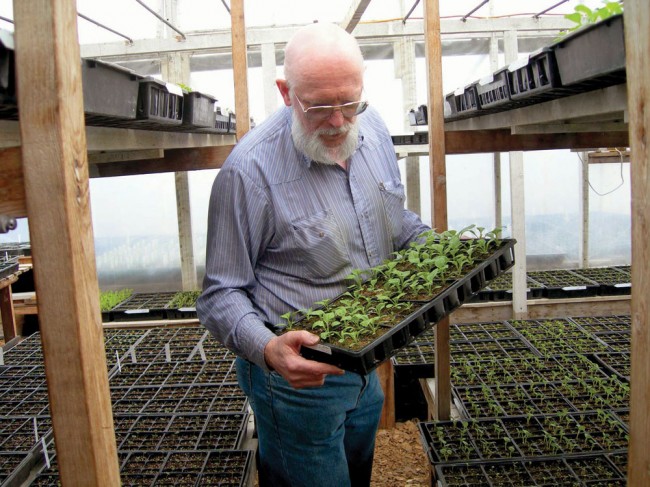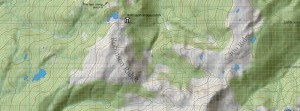
The Northern Garden Gamble: know when to hold ‘em, know when to sow ‘em
When the robins are back and the pussy-willows are in their prime, northern gardeners emerge from hibernation and start pacing around the piles of snow and sodden earth, trying their best to be patient until spring really arrives so the planting can begin.
With each passing day, avid green thumbs look at the overnight temperatures and place their bets. Can I get away with planting peas one week earlier than last year? Will I get to the broccoli before the deer eat it all? Will this be the year that I grow a pumpkin that is bigger than a soccer ball? Even the most experienced gardeners can never really tell. Gardening in a northern climate is a combination of calculated risks, wild experiments and good old finger-crossing.
Hildo Hoek, market gardener and long-time Bulkley Valley resident, shares a few ideas about when to plant. “You can direct-seed vegetables like spinach, Swiss chard, radishes, peas, beets, and lettuce usually at the beginning of May. These are all frost-hardy and will survive cooler temperatures so long as it doesn’t freeze too hard. If you know that it is going to get cold, you can cover them up and they will usually do OK. Even when the air temperature drops below zero, the soil stays warmer, so you can push your luck a little.”
At the same time, he is also starting broccoli, cabbage, cauliflower, kohlrabi, and brussel sprouts in trays in the greenhouse. “I like to start my brassicas (cabbage family vegetables) at the beginning of May, about four weeks before I want to plant them out. It is enough time to get some small plants, but more than that is a lot of extra work, and you don’t want your plants to be too big anyway.” Hoek confirms that early to mid-May is also a good time to plant potatoes. “Potatoes are planted about two inches under the soil, which offers quite a lot of frost protection.” He also direct-seeds broad beans in mid-May. Zucchini and other squash are started in trays in the greenhouse in early May.
A few weeks later, the May long weekend rolls around, the prime planting weekend for many northerners. “I usually transplant the brassicas into the garden around the May long weekend, as well as lettuce I’ve started in trays.” Hoek also direct-seeds carrots and beans at this time. “Beans need heat—about 55°F (13°C) or so, so if it is colder than that you should wait a week or two. Otherwise the seed will rot in the ground.”
The last to be put out in the garden are the zucchinis and squash. “They are frost tender, so you really do have to wait. I plant at the end of May because I don’t want to lose all the work it took to grow them in the greenhouse.”
Northern advice
Hoek recommends the book Gardening Between Frosts by his friend and fellow gardener Dave Havard. “It’s the best $10 you can spend for northern gardening advice.” His other tip is to read the seed catalogues. “All the catalogues have good descriptions of when to plant, how far to space, and how many days you need for growing to maturity. All the information is there, and if you pay attention to it you will save yourself a lot of headaches.”
As for site-specific information, keeping a journal or notebook will give you valuable information. Hoek says, “Keeping good records is not difficult and it can help you down the road if something doesn’t work out. All you have to do is go through the garden with a piece of paper, number the rows and mark down what you planted, when and where. Go through the garden mid-season and write down anything that seems off, like seed not germinating, or if something is doing really well.” Keeping a journal of weather conditions will also help you distinguish important facts from hazy impressions. Each growing year is different and taking notes will help make sense of the successes and failures that seem random at first glance.
Keeping notes and making observations also helps you get to know your soil and the unique characteristics of your garden. Two gardens on the same property can be very different, depending on the aspect, slope, soil, sun and shade. Not all gardens and soils will support all crops. For example, poorly drained soil in spring will make it hard to grow garlic and a heavy clay layer close to the surface is not good for growing carrots. “Grow according to what your garden will let you,” Hoek advises. “I tried asparagus for years, but my soil just wouldn’t support it. You have to experiment and over time you will learn what works.”
Familiarity breeds better results
Getting to know common diseases and soil pathogens is also important. For example, club root is a fungus that attacks plants in the brassica family and makes them unviable as a crop. Once in the soil, it takes 15 years of not planting brassicas to get club root out of the soil system. Potato blackleg is a bacterial infection that causes potato plants to rot and turn black near the soil surface, and causes black lesions in the mature potato tuber. Being able to identify diseases and problems when they occur will help you stop them from spreading, as well as lead you to plant varieties that will be successful in your garden. Not all crops are bothered by the same diseases, so don’t despair. If you can’t grow one thing, try something else.
Adding things to your soil can also be a risky business. Try a couple of seasons without adding anything to see what grows well naturally, and take note of problems. Sending a soil sample to a lab can help diagnose diseases or nutrient deficiencies clearly, which makes solving problems easier. If you are adding grass clippings or other material as mulch, be sure that the material has not been treated with pesticides or herbicides. In the same way, if you are importing manure from a farm, confirm that nearby fields have not been sprayed. Some pesticides and herbicides will concentrate in manure and if these chemicals get into the garden, very little will grow and it can be almost impossible to reverse the damage. Be cautious with adding wood ash to gardens; large amounts will make the soil more alkaline which makes it more difficult for most plants to absorb nutrients. Alkaline conditions also contribute to potato scab. Keep in mind that it is very easy to add something to a garden, but very difficult to remove it, so be sure you understand the issue and the soil before experimenting.
Each spring is a chance to try something new. Gardening knowledge is gained slowly over time as you get to know your specific site and what it can support. Taking risks and pushing your luck can be fun and rewarding, so long as you remain optimistic and recognize that gardening is a lifelong endeavour.





